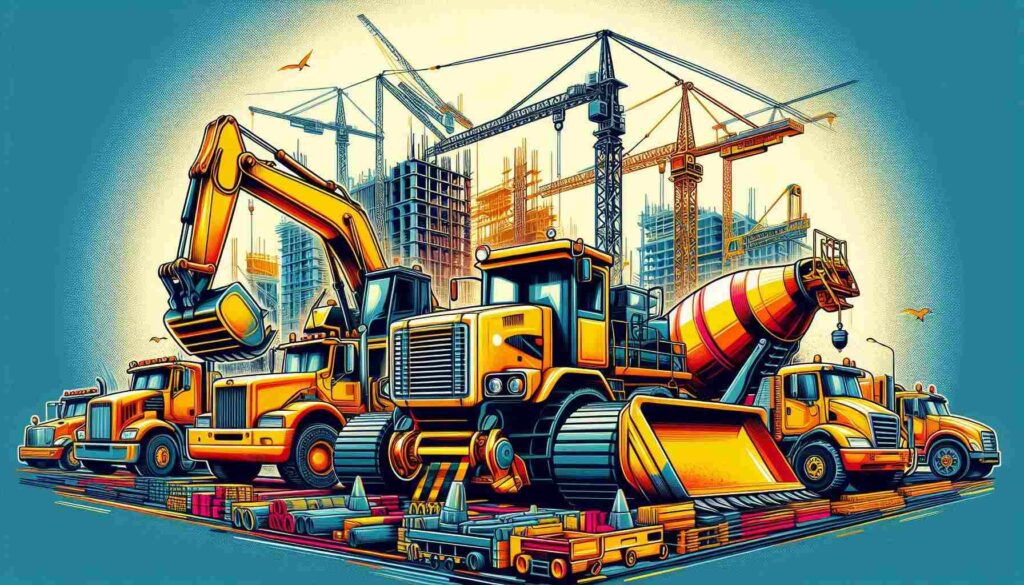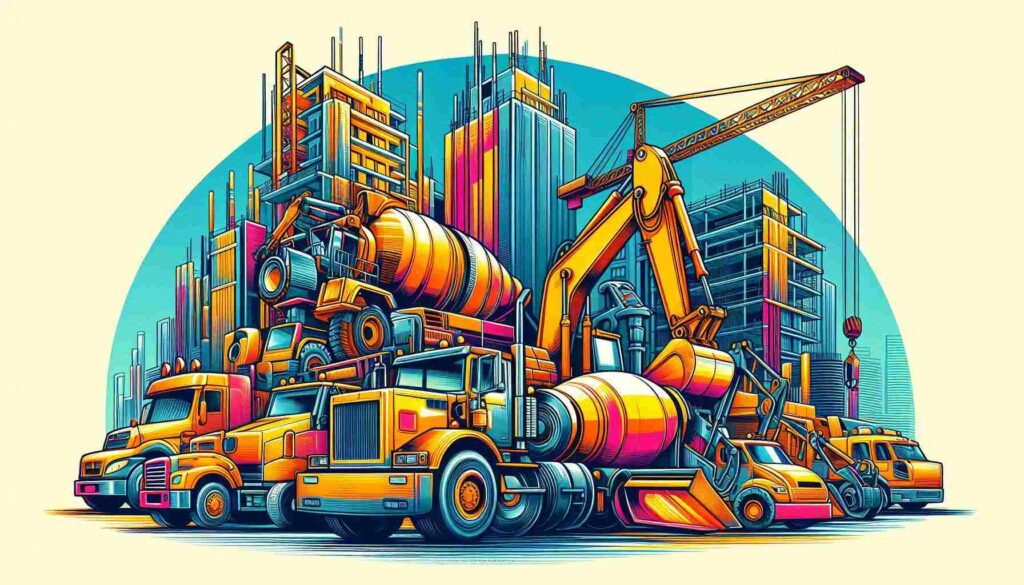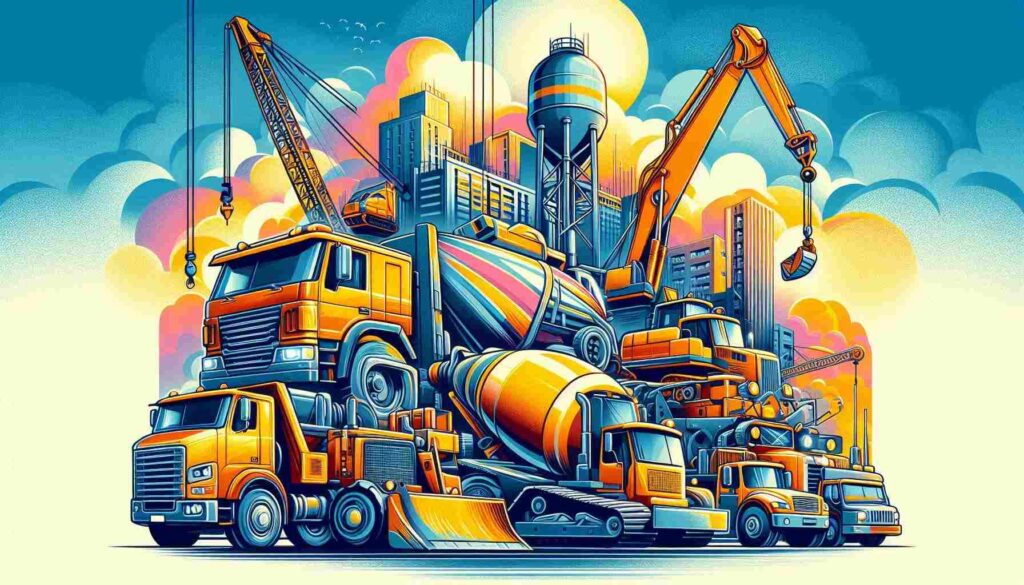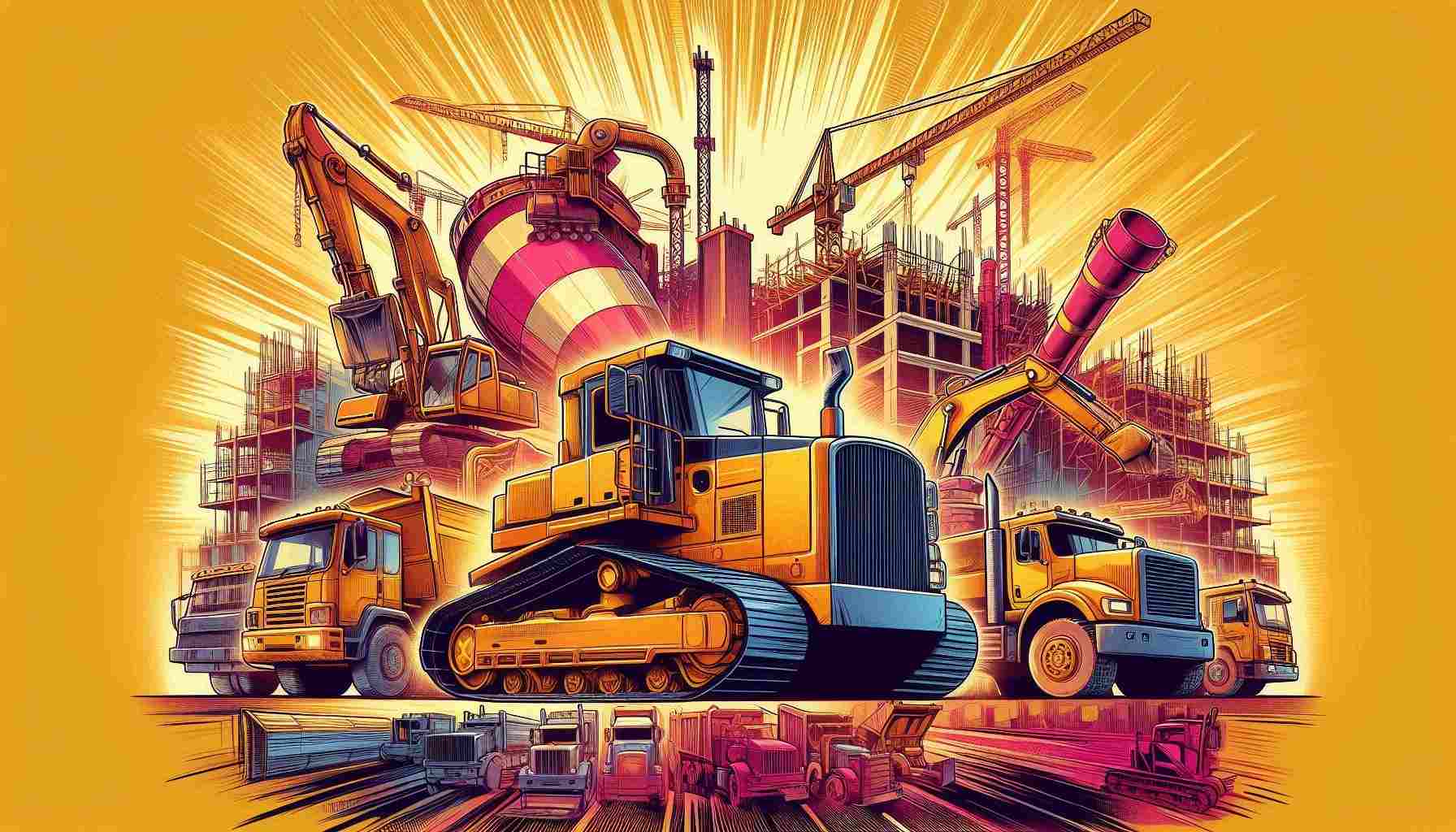A bustling construction site, filled with massive machines moving earth, lifting heavy materials, and shaping the landscape. These aren’t just big toys for grown-ups; they’re the backbone of the construction industry. Construction vehicles are the unsung heroes that turn architectural dreams into concrete reality. Without them, our skylines would be a lot less impressive, and our infrastructure would crumble faster than a sandcastle at high tide.
As someone who’s spent years around these mechanical marvels, I can tell you that they’re not just about raw power. They’re marvels of engineering, each designed for specific tasks that make building projects possible. From the humble wheelbarrow to the towering crane, every piece of equipment plays a crucial role in bringing our built environment to life.
Key Takeaways
- Construction vehicles are specialized machines designed for various tasks in building projects.
- They significantly increase efficiency, safety, and the scale of construction work.
- Different types of vehicles serve specific purposes, from excavation to material transport.
- Proper selection and operation of these machines are crucial for project success.
- Technological advancements are continuously improving the capabilities of construction vehicles.

Types of Construction Vehicles and Their Functions
Let’s dive into the nitty-gritty of these mechanical workhorses. Each type of construction vehicle has its own superpower, and knowing when to use which one can make or break a project. Trust me, I’ve seen projects go south just because someone thought a backhoe could do an excavator’s job. Spoiler alert: it can’t.
Excavators: The Earth-Moving Maestros
Excavators are like the Swiss Army knives of construction sites. These bad boys can dig trenches, holes, and foundations with the precision of a surgeon. I remember this one time on a residential project, we had to dig around some old tree roots. Our excavator operator maneuvered that bucket like he was performing a delicate dance. It was poetry in motion, I tell ya.
Key features of excavators include:
- A rotating cab for 360-degree movement
- Hydraulic arms with attachable tools
- Tracked wheels for stability on uneven terrain
Bulldozers: The Ground-Leveling Giants
If excavators are surgeons, bulldozers are the bruisers of the construction world. These powerful machines are all about pushing large quantities of earth, debris, or rubble. They’re the go-to guys for clearing land, grading, and even helping with demolition. I’ve seen a skilled dozer operator create a perfectly level building pad in what seemed like minutes. It’s like watching a hot knife slice through butter.
Bulldozers are characterized by:
- A large, flat metal blade in front
- Raised tracks for mobility in muddy conditions
- Optional rear ripper for breaking up hard ground
Cranes: The Sky-High Lifters
Ah, cranes. These gentle giants are the reason our cities can scrape the sky. They’re essential for lifting and moving heavy materials to great heights. I remember working on a high-rise project where the crane operator had to place a steel beam with millimeter precision. It was like watching a game of Jenga, but with multi-ton pieces and much higher stakes!
Different types of cranes include:
- Tower cranes for tall buildings
- Mobile cranes for versatility across job sites
- Rough terrain cranes for uneven ground
Loaders: The Multi-Tasking Marvels
Loaders are the workhorses of any construction site. These versatile machines can scoop, lift, and transport materials with ease. They’re like the helpful friend who’s always ready to lend a hand. I’ve seen loaders do everything from clearing snow to placing pipes in trenches. Their adaptability makes them indispensable on almost any project.
Common types of loaders are:
- Wheel loaders for quick movement and versatility
- Skid steer loaders for tight spaces and maneuverability
- Backhoe loaders combining digging and loading capabilities
Dump Trucks: The Heavy Haulers
No construction site is complete without the rumble of dump trucks. These behemoths are the unsung heroes of material transport. They haul everything from excavated earth to demolition debris. I once worked on a road project where we had a constant parade of dump trucks moving mountains of gravel. It was like watching a well-choreographed dance of diesel and dust.
Dump trucks come in various configurations:
- Standard dump trucks for general hauling
- Articulated dump trucks for off-road conditions
- Transfer dump trucks for increased capacity

The Impact of Construction Vehicles on Project Efficiency
Now, you might be thinking, “Sure, these machines are cool, but do they really make that much difference?” Let me tell you, the impact of construction vehicles on project efficiency is nothing short of revolutionary. They’re not just tools; they’re game-changers.
First off, let’s talk about speed. What used to take hundreds of workers weeks or months to do can now be accomplished in days or even hours with the right machinery. I remember a site clearance job that would’ve taken a crew with shovels months to complete. With an excavator and a couple of dump trucks, we had it done in a week. It’s not just about brute force; it’s about working smarter.
Then there’s the precision factor. Modern construction vehicles are equipped with GPS and computer-controlled systems that allow for incredibly accurate work. This means less waste, fewer errors, and ultimately, a better end product. I’ve seen GPS-guided graders create perfectly level surfaces that would have been nearly impossible to achieve manually.
Safety is another huge benefit. By using machines for heavy lifting and dangerous tasks, we’ve dramatically reduced the risk of injury on construction sites. Don’t get me wrong, safety is still paramount, but these vehicles have taken a lot of the physical strain off workers’ backs – literally.
Let’s not forget about cost-effectiveness. While the initial investment in construction vehicles can be substantial, the long-term savings in time and labor costs are significant. Plus, with proper maintenance, these machines can last for decades, making them a sound investment for any construction company.
But it’s not all rainbows and sunshine. Operating these machines requires skill and training. I’ve seen novice operators turn what should be a simple task into a time-consuming ordeal. That’s why having experienced, well-trained operators is crucial for maximizing the efficiency these vehicles can bring to a project.
As we look to the future of construction, the role of these vehicles is only going to grow. With advancements in automation and electric power, we’re on the cusp of a new era in construction machinery. Imagine remote-controlled excavators or fully electric dump trucks – the possibilities are exciting.
But for now, let’s appreciate the incredible impact these machines have on our ability to build bigger, faster, and safer. In the next section, we’ll dive into how to choose the right vehicle for your specific project needs, because as any seasoned construction pro will tell you, having the right tool for the job is half the battle…

Choosing the Right Construction Vehicle for Your Project
Alright, let’s talk about picking the perfect mechanical partner for your construction job. It’s not just about grabbing the biggest, baddest machine you can find. Trust me, I’ve seen projects go sideways because someone thought bigger was always better. Spoiler alert: it’s not.
First things first, you gotta know your project inside and out. What’s the terrain like? Are you working in tight spaces or wide-open areas? How much material are you moving? These questions are your roadmap to vehicle selection.
For excavation work, you might be torn between an excavator and a backhoe. Here’s a pro tip: if you’re digging deep or need a wide range of motion, go for the excavator. Backhoes are great for smaller jobs or when you need both digging and loading capabilities. I once saw a guy try to use a backhoe for a large-scale excavation. Let’s just say it took way longer than it should have.
When it comes to earthmoving, bulldozers are the kings of the hill. But don’t overlook motor graders for fine grading work. They’re like the artists of the construction world, creating smooth, precise surfaces. I’ve watched a skilled grader operator create a perfectly level surface that looked like it was done with a laser level.
For lifting and placing materials, you’ve got options. Tower cranes are great for high-rise projects, but mobile cranes offer flexibility for smaller jobs. And don’t forget about telehandlers – they’re like the Swiss Army knives of lifting equipment. I’ve seen them used for everything from placing roof trusses to unloading trucks.
Remember, the right vehicle isn’t just about capability – it’s about efficiency. Sometimes, renting a specialized machine for a short period can be more cost-effective than trying to make do with what you have. It’s all about finding that sweet spot between capability and cost.
Maintenance and Safety: Keeping Your Vehicles Running Smoothly
Now, let’s talk about keeping these beasts in tip-top shape. Proper maintenance isn’t just about avoiding breakdowns (though that’s a big part of it). It’s about safety, efficiency, and saving money in the long run. I’ve seen projects grind to a halt because of a neglected machine, and let me tell you, it ain’t pretty.
First up, daily inspections are a must. I’m talking about checking fluid levels, looking for leaks, and making sure all the moving parts are, well, moving properly. It’s like giving your vehicle a quick health check every morning. Trust me, catching a small problem early can save you from a massive headache later.
Here’s a quick checklist for daily inspections:
- Check oil and coolant levels
- Inspect hydraulic hoses for leaks
- Test lights and safety equipment
- Look for any loose or damaged parts
- Clean air filters and radiators
But maintenance isn’t just about the machines – it’s about the operators too. Proper training is crucial. I’ve seen skilled operators make difficult tasks look easy, and I’ve seen untrained operators turn simple jobs into disasters. Invest in your team’s skills, and it’ll pay off in spades.
Now, let’s talk safety. Construction sites can be dangerous places, and these powerful machines need to be respected. Always follow manufacturer guidelines and OSHA regulations. Use spotters when necessary, especially in tight spaces or when visibility is limited. And for the love of all things holy, wear your PPE!
One more thing – don’t skimp on quality when it comes to parts and repairs. I’ve seen folks try to save a few bucks with cheap parts, only to end up with bigger, more expensive problems down the line. It’s like that old saying: “Buy cheap, buy twice.”
The Future of Construction Vehicles: What’s on the Horizon?
Buckle up, folks, because the future of construction vehicles is looking mighty exciting. We’re talking about tech that would make the Jetsons jealous. From electric-powered machines to autonomous vehicles, the construction industry is on the cusp of a revolution.
Electric construction vehicles are gaining traction (pun intended). They’re quieter, cleaner, and can significantly reduce a project’s carbon footprint. I recently visited a site using electric excavators, and the difference in noise level was mind-blowing. Plus, no more diesel fumes – your lungs will thank you.
Autonomous and semi-autonomous vehicles are also making waves. Imagine bulldozers that can grade a site with minimal human intervention, or dump trucks that follow optimized routes without a driver. It sounds like science fiction, but it’s becoming a reality. I’ve seen prototype autonomous rollers in action, and let me tell you, they’re more precise than many human operators.
But it’s not just about fancy new machines. The integration of AI and machine learning is revolutionizing how we use existing equipment. Predictive maintenance systems can alert you to potential issues before they become problems. GPS and 3D modeling technologies are improving accuracy and reducing waste. It’s like giving our trusty old machines a brain upgrade.
Of course, with all this new tech comes new challenges. We’ll need operators who are as comfortable with computers as they are with hydraulics. And there are still questions about safety and reliability that need to be ironed out. But from where I’m standing, the future looks bright – and it’s wearing a hard hat.
As we wrap up this journey through the world of construction vehicles, I hope you’ve gained a new appreciation for these mechanical marvels. They’re more than just big, noisy machines – they’re the backbone of our built environment. From the skyscrapers that define our skylines to the roads that connect our communities, construction vehicles play a crucial role in shaping the world around us.
Whether you’re a seasoned construction pro or just someone who’s always been fascinated by big machines, remember this: behind every great building project is a fleet of hardworking vehicles and the skilled professionals who operate them. So next time you pass a construction site, take a moment to appreciate the symphony of machinery at work. It’s a beautiful thing.
Frequently Asked Questions
1. What is the most versatile construction vehicle?
The backhoe loader is often considered the most versatile construction vehicle. It combines the digging capabilities of an excavator with the loading abilities of a front-end loader. This 2-in-1 machine can handle a wide range of tasks, from digging trenches and breaking asphalt to moving materials and grading. Its versatility makes it a staple on many construction sites, especially for smaller to medium-sized projects.
2. How much does it cost to rent a bulldozer for a day?
The cost of renting a bulldozer can vary widely depending on the size of the machine, your location, and the rental duration. On average, you might expect to pay anywhere from $300 to $1,000 per day for a bulldozer rental. Smaller bulldozers typically cost less, while larger, more powerful models will be at the higher end of the price range. It’s always best to get quotes from several rental companies in your area for the most accurate pricing.
3. What’s the difference between an excavator and a backhoe?
While both excavators and backhoes can dig, they have some key differences. Excavators are larger, with a boom, stick, and bucket mounted on a rotating platform. They’re better for heavy-duty digging and can reach further. Backhoes are smaller and more versatile, with a loader bucket in front and a digging arm in back. They’re great for projects that require both digging and material handling. Excavators excel at deep, large-scale excavation, while backhoes are more suited for lighter work and tighter spaces.
4. How do I become a construction vehicle operator?
Becoming a construction vehicle operator typically involves several steps:
1. Get a high school diploma or GED
2. Attend a vocational school or community college for heavy equipment operation
3. Complete an apprenticeship program (often 3-4 years)
4. Obtain necessary certifications (varies by state and equipment type)
5. Gain experience through entry-level positions
Some operators start as construction laborers and work their way up, learning on the job. Safety training and a clean driving record are also crucial. It’s a rewarding career that requires skill, patience, and a good understanding of construction processes.
5. What’s the largest construction vehicle in the world?
The Bagger 293, also known as the Man Takraf RB293, holds the Guinness World Record for the largest land vehicle in the world. It’s a bucket-wheel excavator used in mining operations, standing 310 feet tall and 721 feet long. Weighing in at 14,200 tons, it’s truly a behemoth. While not typical for standard construction projects, it showcases the incredible scale that construction and mining vehicles can reach.
6. How much fuel does a typical excavator use per hour?
Fuel consumption for excavators can vary greatly depending on the size of the machine and the intensity of the work. On average, a medium-sized excavator (around 20-30 tons) might use between 4 to 8 gallons of diesel fuel per hour under normal working conditions. Larger excavators can use up to 15 gallons per hour or more. However, newer models with more efficient engines and hybrid systems are helping to reduce fuel consumption and operating costs.
7. Are there any fully electric construction vehicles available?
Yes, fully electric construction vehicles are becoming increasingly available. Companies like Volvo, Caterpillar, and JCB have introduced electric excavators, loaders, and compact equipment. These machines offer zero emissions, lower noise levels, and reduced operating costs. While they’re still in the early stages of adoption, electric vehicles are expected to play a significant role in the future of construction, especially in urban areas and indoor construction sites where emissions and noise are concerns.
8. How often should construction vehicles be serviced?
The service frequency for construction vehicles depends on the type of machine, usage intensity, and manufacturer recommendations. Generally, a basic service should be performed every 250-500 operating hours or every three months, whichever comes first. This typically includes oil and filter changes. More comprehensive services, including hydraulic system checks and component inspections, are usually done every 1000-2000 hours. Daily inspections by operators are also crucial for catching minor issues before they become major problems. Always consult the manufacturer’s manual for specific service intervals.
9. What safety features are common in modern construction vehicles?
Modern construction vehicles come equipped with a range of safety features:
– Rollover Protection Systems (ROPS) and Falling Object Protection Systems (FOPS)
– 360-degree camera systems for improved visibility
– Proximity sensors and alarms to detect nearby objects or people
– Automated emergency braking systems
– Ergonomic cab designs to reduce operator fatigue
– Telematics systems for remote monitoring and maintenance alerts
– Load moment indicators for cranes to prevent tipping
– Anti-slip surfaces and handrails for safe entry and exit
These features, combined with proper training and safety protocols, help reduce accidents and improve overall site safety.
10. How are GPS and machine control systems changing construction vehicle operation?
GPS and machine control systems are revolutionizing construction vehicle operation. These technologies allow for incredibly precise grading, excavation, and material placement. Operators can work from 3D digital models of the project, with the machine providing real-time guidance. This results in faster work, reduced material waste, and fewer errors. Some systems even allow for semi-autonomous operation, where the machine can perform repetitive tasks with minimal operator input. While the initial investment can be high, many contractors find that the improved efficiency and accuracy quickly pay off in reduced project times and costs.






